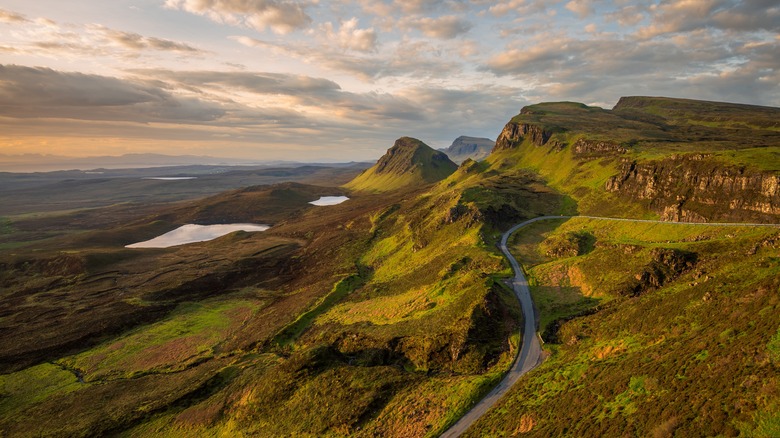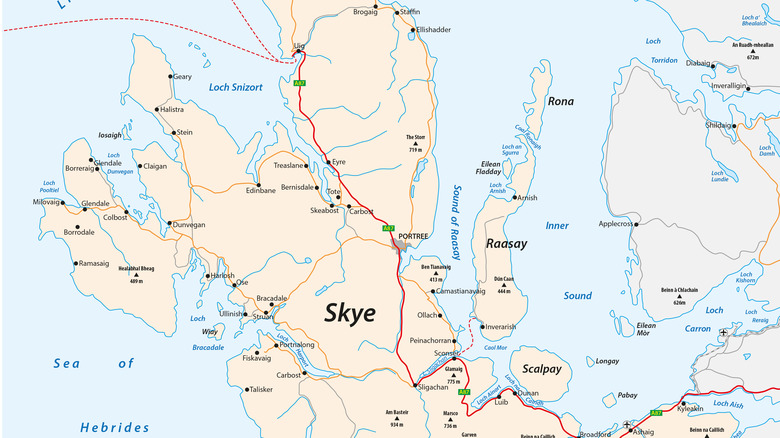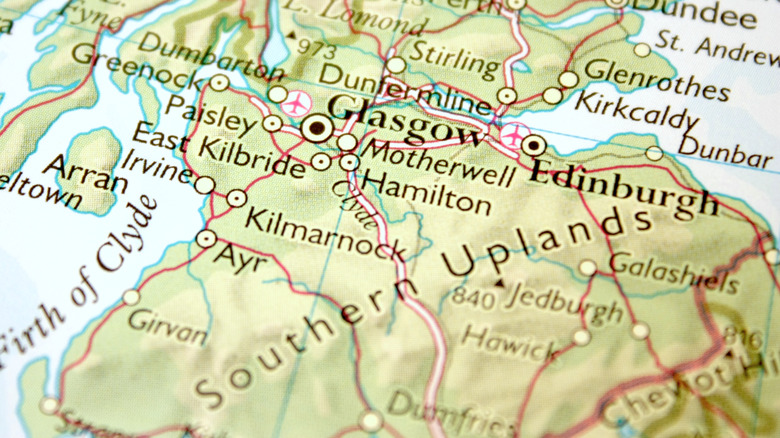The Only Map Of Scotland's Tourist Attractions You Need For Your Upcoming Trip
It's no secret that the country of Scotland is rich in both history and natural beauty. Whether you're exploring all the Scottish Highlands have to offer — including the islands of both the Inner Hebrides and Outer Hebrides — or taking a road trip along the southwestern coast, everywhere you look offers jaw-dropping landscapes and castles (there are over 1,000 scattered across the country!). However, with so much to see, it can be difficult to decide where to begin.
The easiest way to plan your Scotland experience is to recognize that there are different regions to consider. The Highlands to the north are balanced by the Lowlands to the south. That said, the Lowlands themselves are made up of two separate regions: the Central Lowlands, also called the Central Valley or Midland Valley, and the Southern Uplands. Knowing what these regions have to offer will ensure you see the tourist attractions that best suit your interests. And, trust us: You're going to want to dig deeper than the sites everyone knows about. Take Scotland's first national park, Trossachs National Park, for example, which is home to the country's biggest loch and is less crowded than Loch Ness. At the end of the day, no matter where you're planning to go, keep reading to learn more about what you can find on and off the beaten path in this beautiful country.
The Scottish Highlands
The Scottish Highlands are all about sweeping scenic views. One of the most popular destinations in the region is a valley resting in the central Highlands called Glencoe. Just 23 miles south of Ben Nevis — the UK's tallest mountain with some of the most demanding trails in the area — the stunning landscape is easily drivable via the A82 highway. For those who have the time to stop and explore, hikes like the 2.5-mile Coire Gabhail, or the longer 5-mile Buachaille Etive Beag, offer spectacular views. For even more hiking options, don't miss Cairngorms National Park (the UK's largest), and Loch Lomond, Britain's largest loch, located in the Trossachs National Park, which also happens to be the country's first national park.
The Highlands are also the place for fans of the television series "Outlander." The city of Inverness, for example, is largely recognized as the capital of the Highlands, and features as the story's opening location. Beyond the famed Loch Ness, there are also plenty of other things to see. A short drive away, you'll find the 4,000-year-old cluster of standing stones at Clava Cairns — which also happens to be the site that inspired the fictional Craigh na Dun, where Claire Fraser travels back in time. Just 33 miles from Inverness, you'll find another "Outlander" link at Plodda Falls, an underrated waterfall that looks straight out of a movie. Located on the lands of Clan Fraser, the waterfall is heavily featured throughout the series.
History buffs can also visit Culloden Battlefield at Culloden Moor, the site of the famous battle where the Jacobite rising was crushed by British forces in 1746. Other popular stops include the Inverness Castle Experience at Castle Wynd — a series of multimedia exhibits showcasing the area's rich history — and the Inverness Museum and Art Gallery.
The islands of Scotland
There's a reason almost everyone has heard of the Isle of Skye. Famed for its breathtaking landscapes, this European island offers a scenic vacation at a low cost. Part of the Highlands and situated off the western coast of Scotland, the Isle of Skye is full of picturesque villages and medieval castles. And, although separate from the mainland, it's not difficult to get to. The local ferry service is easy to take advantage of, and you can even drive there via the Skye Bridge. Some of the island's main attractions include visiting the Dunvegan Castle and Gardens (home of Clan MacLeod), climbing the Old Man of Storr (a 2.4-mile trek that's challenging but rewarding with its spectacular views), and swimming in the Fairy Pools at Glen Brittle.
What you may not realize is that Scotland's most well-known island is part of the Inner Hebrides archipelago — a group of islands off the Atlantic coast that span 150 miles. This area boasts the other larger islands of Jura and Islay, as well as what may be Scotland's most underrated island: a pristine little paradise of cliffs, beaches, and mountains called the Isle of Mull. As the second largest of the Inner Hebrides, Mull has a lot to offer, including extraordinary maritime wildlife viewing — you can expect to see dolphins, whales, otters, and seals — lighthouses, and Duart Castle, which overlooks the Sound of Mull and Loch Linnhe.
Other smaller islands that constitute the Inner Hebrides include Soay, Scalpay, Raasay, and Rona. Plus, there are also the Outer Hebrides to consider. Located further off the northwestern coast of Scotland, these islands stretch for 130 miles, forming a crescent about 40 miles from the mainland. Visit Lewis in the north to explore various beaches, parks, and gardens, and Barra in the south for lovely landscapes and quaint villages.
The Central Lowlands
Unsurprisingly, just south of the Scottish Highlands is where you'll find the Scottish Lowlands, which stretch all the way to the border of England. The Lowlands are divided into two separate sections: the Central Lowlands and the Southern Uplands. The Central Lowlands are home to the country's largest cities by population, beginning with Glasgow. Ironically, this often overlooked city was named the most underrated destination in all of Scotland, according to Rick Steves. It's often outshined by Scotland's capital and second largest city, Edinburgh, for one big reason: Edinburgh has the country's busiest airport, making it a natural beginning and ending place for tourists. That being said, Glasgow is only about an hour drive from its more popular counterpart, and offers historic architecture, world-class museums, and an active dining and night life.
The Central Belt is also home to more than half of the country's population. Best of all, you'll find this region to be one of the most well-connected due to its denser population, equipped with ample bus and train options. For a more urban experience, visitors can visit Perth for historic streets, castles and parks, and Dundee, Scotland's fourth largest city, which was once a major industrial center known for its three J's: jute, jam, and journalism.
When it comes to the landscape of the Lowlands, they're probably more topographically diverse than you'd expect given the name. In terms of hiking, this area includes some challenging hills available for exploration. Meanwhile, those looking for a milder walking option will enjoy the Fife Coastal Path, which begins in Kincardine and ends in Newburgh. Stretching for 117 miles, and taking about eight days to complete, this route will take you past beautiful beaches, through historic seaside villages, and even by some old smuggling caves.
The Southern Uplands
There's no shortage of summits to climb in the mountainous Southern Uplands. From quaint villages to trails for hiking and biking, this is the place for those looking to explore the great outdoors. For picturesque forest trails, look not further than Galloway Forest Park, featuring two main visitor hubs: Kirroughtree and Glentrool. While the former is ideal for active adventures, the latter boasts beautiful woods, water, hills, and history. Visitors can enjoy nature from the comfort of their car along Forest Drive, and observe wildlife like red deer and wild goats. To get the blood flowing, hike up The Merrick, with the highest summit in Southern Scotland, or visit Bennan Viewpoint, which boasts views of Loch Ken after a short climb.
Located on Scotland's southwestern tip, Logan Botanical Garden is a must-see for any plant enthusiast. Warming from the Gulf Stream mimics a subtropical climate, creating the perfect home for palm trees, ferns, eucalyptus, and giant gunnera. Other coastal gardens in the same area include the 300-year-old Kennedy Gardens and the late-19th and early-20th-century woodland paradise at the Ardwell House.
For an all-encompassing plan to see the Uplands, the South West Coastal 300 is Scotland's underrated road trip route with fewer crowds than the popular North Coast 500. This 300-mile circular route has something for everyone, whether you're interested in nature, castles, or just enjoying this beautiful country's culture and history. Beginning on the southwestern coast before jutting inland to pass Galloway Forest Park, must-see stops on the route include a series of castles, such as Culzean Castle — offering a glimpse into Scottish wealth in the 18th century — and Dundonald Castle, Dunure Castle, and Caerlaverock Castle, all of which are about 700 years old.




